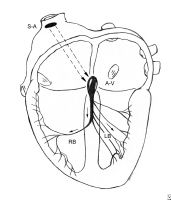Supraventricular tachycardia is a rapid heart rate (tachycardia, or a heart rate above 100 beats per minute) that is caused by electrical impulses that originate above the heart's ventricles. Many physicians include all of the many tachycardias that involve the atrioventricular node (AV node) under this classification, but others do not. Supraventricular tachycardia does not include those tachycardia rhythms that originate from the ventricles (ventricular tachycardias) such as ventricular tachycardia or ventricular fibrillation. Supraventricular tachycardia is also called paroxysmal supraventricular tachycardia and abbreviated either SVT or PSVT.
The following is a brief description of the heart's normal electrical activity. This is presented so that the abnormal electrical activity can be better understood:
Nerve impulses, oxygen demand, the level of hormones in the blood, and other factors influence the rate of heart contraction at any given time. A problem in any of these areas can cause abnormal heart rhythm (arrhythmia or dysrhythmia).
In supraventricular tachycardia, the heart rate is sped up by an abnormal electrical impulse starting in the atria.
Supraventricular tachycardia often occurs in episodes with stretches of normal rhythm in between. When tachycardia occurs, it is usually referred to as paroxysmal supraventricular tachycardia (often abbreviated PSVT). Supraventricular tachycardia also may be chronic (ongoing, long-term).
The following is a list of conditions that fit under the broad definition of SVT:
There are two semantic problems in the literature with supraventricular tachycardias (SVTs). From the strict but extremely broad definition, an SVT can be due to any supraventricular cause. Consequently, atrial fibrillation, atrial flutter, paroxysmal supraventricular tachycardia, and even normal exercise-induced tachycardia could fall under this designation. However, many clinicians consider SVT to be only paroxysmal supraventricular tachycardia (PSVT). The terminology may be somewhat confusing, but the large majority of SVTs are usually discussed separately in articles under their specific name (for example, atrial fibrillation). Because the principal SVTs listed above have separate articles devoted to them in eMedicineHealth, this article will be devoted only to paroxysmal supraventricular tachycardia (PSVT).
The following is a brief description of the heart's normal electrical activity. This is presented so that the abnormal electrical activity can be better understood:
- The heart consists of four chambers; two upper chambers called atria and two lower chambers called ventricles.
- The atria receive blood from blood vessels and, with coordinated electrical impulses from the sinoatrial (SA) node, contract to push blood into the ventricles.
- The ventricles then contract to push the blood out of the heart into the blood vessels of the lungs and to the rest of the body.
- The heart usually beats 60-90 times a minute. A heart rate faster than 100 beats per minute is considered tachycardia.
- These specialized cells consist of the SA or sinus node in the right atrium and the AV node and the bundle of His in the wall between the right and left ventricles.
- The SA node, the natural pacemaker of the heart, starts the electrical signals and transmits them to the AV node.
- The AV node then activates the bundle of His and its branches, resulting in contraction of the ventricles.
- The atria contract to fill the ventricles with blood; then the ventricles contract in quick sequence to move the blood into the lungs and the rest of the body. Each sequence of atrial then ventricular contraction is one normal heartbeat.
Picture of electrical pathways of the heart
SA node and AV node and the path of the electrical impulse into the ventricles through the bundle of His and to the right and left ventricle nerve bundles (RB and LB) to complete a heartbeat
Nerve impulses, oxygen demand, the level of hormones in the blood, and other factors influence the rate of heart contraction at any given time. A problem in any of these areas can cause abnormal heart rhythm (arrhythmia or dysrhythmia).
In supraventricular tachycardia, the heart rate is sped up by an abnormal electrical impulse starting in the atria.
- The heart beats so fast that the heart muscle cannot relax between contractions.
- When the chambers don't relax, they may not contract strongly or fill with enough blood to satisfy the body's needs at rest or especially during times of increased oxygen demand (for example stress, body movements, and walking).
- Because of the ineffective contractions of the heart, the brain does not receive enough blood and oxygen. People can become light-headed, dizzy, or feel like fainting (syncope).
Supraventricular tachycardia often occurs in episodes with stretches of normal rhythm in between. When tachycardia occurs, it is usually referred to as paroxysmal supraventricular tachycardia (often abbreviated PSVT). Supraventricular tachycardia also may be chronic (ongoing, long-term).
The following is a list of conditions that fit under the broad definition of SVT:
- Sinus tachycardia
- Inappropriate sinus tachycardia (IST)
- Sinus nodal reentrant tachycardia (SNRT)
- Atrial tachycardia
- Multifocal atrial tachycardia (MAT)
- Atrial flutter (AF)
- Atrial fibrillation (A fib)
- Paroxysmal supraventricular tachycardia (PSVT; also termed AV nodal reentrant tachycardia or AVNRT and AV reentrant tachycardia or AVRT, a subset of PSVT)
- Junctional ectopic tachycardia (JET)
- Nonparoxysmal junctional tachycardia (NPJT)
There are two semantic problems in the literature with supraventricular tachycardias (SVTs). From the strict but extremely broad definition, an SVT can be due to any supraventricular cause. Consequently, atrial fibrillation, atrial flutter, paroxysmal supraventricular tachycardia, and even normal exercise-induced tachycardia could fall under this designation. However, many clinicians consider SVT to be only paroxysmal supraventricular tachycardia (PSVT). The terminology may be somewhat confusing, but the large majority of SVTs are usually discussed separately in articles under their specific name (for example, atrial fibrillation). Because the principal SVTs listed above have separate articles devoted to them in eMedicineHealth, this article will be devoted only to paroxysmal supraventricular tachycardia (PSVT).

No comments:
Post a Comment